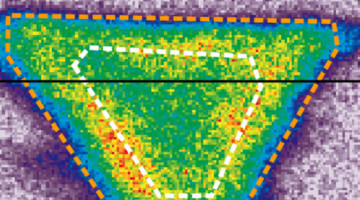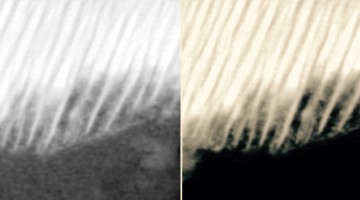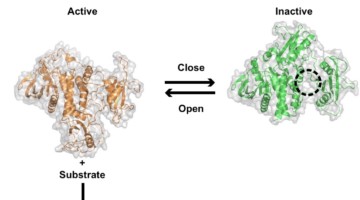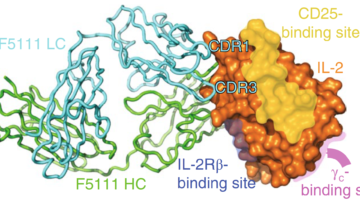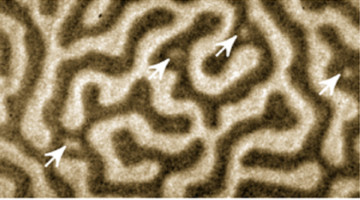In the first comprehensive study at the ALS involving nanoARPES, researchers probed the electronic effects of defects in monolayer tungsten disulfide at the nanoscale. The extremely small scale of the measurements makes nanoARPES a great discovery tool that will be particularly useful for understanding new materials as they are invented. Read more »
Science Briefs
Salt in the Amazon Air Comes from Local Fungi
The abundant salt in the atmosphere above the Amazon basin has long been attributed to the Atlantic Ocean. But now, using the Advanced Light Source, scientists have found that much of it originates much more locally: fungal spores in the rainforest. Pinpointing the origin will improve climate models and understanding of rainforest ecosystems. Read more »
Meteorites Suggest Galvanic Origins for Martian Organic Carbon
Nanoscale analyses of Martian meteorites suggest that organic carbon on Mars may have been formed by electrochemical reactions between briny liquids and volcanic minerals, as might occur in a galvanic cell. The study has major implications for astrobiology and could also shed light on the reactions that led to life on the early Earth. Read more »
Hidden Flow of Lithium Ions Points Way to Better Batteries
Experiments revealed that lithium ions unexpectedly flow along the surfaces of electrode particles, boosting the growth of lithium “hot spots” that shorten battery life. The results correct decades’ worth of assumptions and will help improve battery design, potentially leading to a new generation of lithium-ion batteries. Read more »![]()
Locking Protein Structure to Close the Door on Cancer
While the SHP2 protein helps regulate cellular activity, mutations in its structure can lead to cancer. X-ray crystallography at the ALS and SSRL has revealed differences between normal and mutated SHP2, as well as how it binds to certain cancer drugs. These structural insights open the door to new types of cancer therapy. Read more »
Palladium and Zirconium Convert Greenhouse Gases into Fuel
Greenhouse gases cause the rising global temperatures associated with climate change. At the ALS, researchers have determined that palladium/zirconium catalysts can reduce greenhouse gases like methane and carbon dioxide by converting them into useful fuel. Read more »![]()
Tunable Ferromagnetism in a 2D Material at Room Temperature
Researchers combined soft x-ray spectroscopy and microscopy to demonstrate the tunable ferromagnetic characteristics of a two-dimensional layered material at room temperature. The results open up exciting opportunities for the use of such materials in low-power spintronics, high-density magnetic storage, and flexible electronics. Read more »
Antibody Therapy for Autoimmune Diseases
The balance between two types of white blood cells is disrupted in autoimmune diseases. Using protein crystallography, scientists have identified a human antibody that locks interleukin-2, a signaling protein, in a conformation that preferentially activates one cell type to restore the balance and treat autoimmune diseases. Read more »
Unwinding a Quadruple Helix
The double helix is not the only structure formed by DNA and RNA. Guanine-rich DNA and RNA sequences can fold into quadruple-helix structures called G-quadruplexes. Recently, researchers visualized the unfolding of a G-quadruplex by a protein called DHX36, gaining valuable insight into a potential target for drug development. Read more »
Ordered Magnetic Patterns in a Disordered Magnetic Material
Scientists have confirmed the presence of chirality, or handedness, in nanometers-thick samples of amorphous (noncrystalline) multilayer materials. The chirality—which potentially could be exploited to transmit and store data in a new way—was observed in the domain walls between neighboring regions of opposite spin. Read more »
- « Previous Page
- 1
- …
- 12
- 13
- 14
- 15
- 16
- …
- 23
- Next Page »
